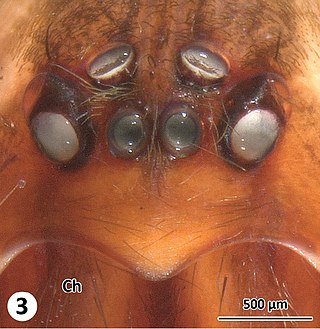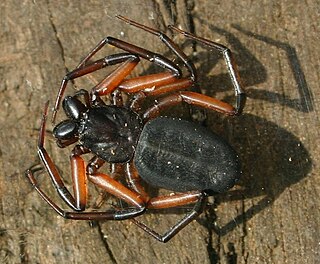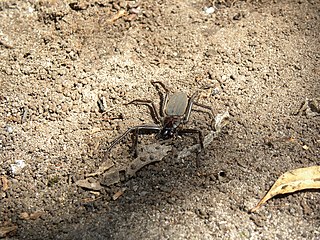
Oonopidae, also known as goblin spiders, is a family of spiders consisting of over 1,600 described species in about 113 genera worldwide, with total species diversity estimated at 2000 to 2500 species. The type genus of the family is OonopsKeyserling, 1835.

Norman Ira Platnick was an American biological systematist and arachnologist. At the time of his death, he was a professor emeritus of the Richard Gilder Graduate School and Peter J. Solomon Family Curator Emeritus of the invertebrate zoology department of the American Museum of Natural History. A 1973 Ph.D. recipient at Harvard University, Platnick described over 1,800 species of spiders from around the world, making him the second most prolific spider taxonomist in history, behind only Eugène Simon. Until 2014 he was also the maintainer of the World Spider Catalog, a website formerly hosted by the AMNH which tracks the arachnology literature, and attempts to maintain a comprehensive list, sorted taxonomically, of every species of spider which has been formally described. In 2007 he received the International Society of Arachnology's Bonnet award, named for Pierre Bonnet, in recognition of his work on the catalog.

Austrochilidae is a small spider family with nine species in two genera. Austrochilus and Thaida are endemic to the Andean forest of central and southern Chile and adjacent Argentina.

Cithaeronidae is a small family of araneomorph spiders first described by Simon in 1893 Female Cithaeron are about 5 to 7 millimetres long, males about 4 millimetres (0.16 in).

Gallieniellidae is a family of spiders first described by J. Millot in 1947. It was originally thought to be endemic to Madagascar until species were also found in southern Kenya, northeastern Argentina, and Australia. Drassodella was transferred from the family Gnaphosidae in 1990. They are suspected to be specialized in ant-preying.

Trochanteriidae is a family of spiders first described by Ferdinand Karsch in 1879 containing about 52 species in 6 genera. Most are endemic to Australia though Doliomalus and Trochanteria are from South America and Plator is from Asia. Platyoides species exist in southern and eastern Africa, Madagascar, and the Canary Islands with one species, P. walteri, introduced to Australia.

The Gnaphosoidea or gnaphosoids are a superfamily of araneomorph spiders with seven families. A 2014 study did not find the group to be monophyletic.
Calponia is a monotypic genus of araneomorph spiders in the family Caponiidae, containing the single species, Calponia harrisonfordi. It was first described in 1993 by Norman I. Platnick, who named the type species after the film actor Harrison Ford to thank him for narrating a documentary for the Natural History Museum in London. It has only been found in California in the United States.

Platyoides is a genus of spiders belonging to the family Trochanteriidae. Its members are known as scorpion spiders and are found in sub-Saharan Africa and its islands, Madagascar, Réunion, Aldabra and the Canary Islands.

Caponiidae is a family of ecribellate haplogyne spiders that are unusual in a number of ways. They differ from other spiders in lacking book lungs and having the posterior median spinnerets anteriorly displaced to form a transverse row with the anterior lateral spinnerets. Most species have only two eyes, which is also unusual among spiders. A few species of Caponiidae variously have four, six or eight eyes. In some species the number of eyes will increase when the spiderling changes its skin as it grows towards adulthood.
Barrowammo is a genus of North and West Australian termite hunters containing the single species, Barrowammo waldockae. It was first described by Norman I. Platnick in 2002, and has only been found in Australia. The name is a portmanteau of Barrow Island and Ammoxenidae.
Boolathana is a genus of spiders in the family Trachycosmidae found in western Australia. There are two species in the genus, Boolathana mainae and Boolathana spiralis. It is named after Boolathana Station, a pastoral lease near where the first specimen was found.
Inthaeron rossi is a species of araneomorph spider endemic to India in the family Cithaeronidae, that was described by Norman I. Platnick in 1991.
Austrammo is a genus of Australian ground spiders first described by Norman I. Platnick in 2002.
Peeto is a monotypic genus of Australian araneomorph spiders in the family Trachycosmidae containing the single species, Peeto rodmani. It was first described by Norman I. Platnick in 2002, and has only been found in Australia.
Talanites is a genus of ground spiders that was first described by Eugène Simon in 1893.

Morebilus is a genus of spiders in the family Trachycosmidae found in southern and western Australia, first described by Norman I. Platnick in 2002. These are large spiders, with the carapace of males ranging from 10 to 16 millimeters and those of females ranging from 10 to 24 millimeters. They look similar to members of Rebilus, especially the spinneret and tarsal claw, but members of this genus have an inclined lip at the anterior edge of the sternum as well as a pair of enlarged sclerites on the coxal glands.
Cithaeron is a genus of araneomorph spiders in the family Cithaeronidae, first described by O. Pickard-Cambridge in 1872.
Oreo is a genus of Australian araneomorph spiders in the family Trachycosmidae, and was first described by Norman I. Platnick in 2002. The name derives from the Oreo cookie. The type species has a black and white abdomen, although such coloration is common among gallieniellids.
Neato is a genus of Australian araneomorph spiders in the family Trachycosmidae, and was first described by Norman I. Platnick in 2002.








